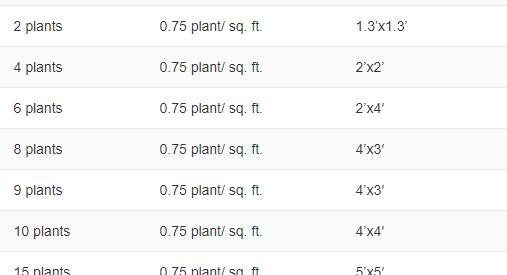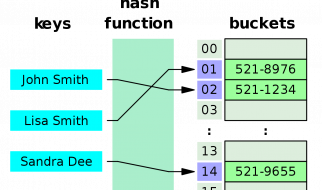Most popular size grow tent, the 4 x 4 indoor grow tent is a perfect match for both new growers and experienced growers looking to harvest 6+ medium to large plants every 3 months. The footprint of the 4×4 grow tent fits a 600 to 1000 watt grow light (or equivalent) and fits in almost anywhere in a home making it easy to hide away for a secluded grow. Using a grow tent to house your plants is great for keeping them free of outside contaminants, makes for easy odor and heat control, and keeps everything self contained.
44 Yield Under Different Styles(or Density)
At this point, how many plants you can grow on a 44 space? And what impacts it has on the total yield?
That brings us to the question that, what growing style you are going to follow? Is ScrOG, SOG, Bush, Mesh or low-stress training?
Well, the style and number of plants to grow in a 44 size really depend on the way you?re training your plants, the strain and so on.
The question of the moment is, how many plants in a 44 grow tent should you grow for a good outcome? Well, apart from some special cases, here are the best plant density for maximum growth in a 44 grow tent-
- If you?re growing SOG: 4?16 plants per m2.
- If you?re growing Pruning: 1 plants per m2.
- If you?re growing with low-stress training: 4 plants per m2.
- If you?re growing ScrOG: 1 plant per m2.
Sea of Green (SOG) ? 1 sq/ft per plant
Sea of Green forces plants into the flowering stage at a very early age.
In fact, after about only two weeks in the vegetative stage you?ll switch the lights to 12/12.
This forces them into flowering so soon you?re able to get more harvests per year- which is one of the reasons people love this technique
After a canopy of buds has started to form, start trimming all the leaves, so the plant spends all of its energy into bud growth.
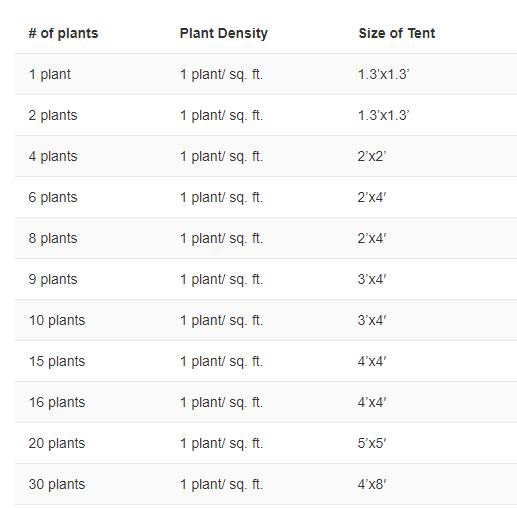
Screen of Green (SCROG) ? 4?6 sq/ft per plant
Screen of Green trains your plant horizontally forming these monster bushes.
If you?re limited on space, growing with SCROG is one of the best ways to make use of what you have.
It works by spreading the tops through a horizontal screen that?s placed above the plants.
Spreading the plant this way encourages bud growth on the branch stems that are normally neglected.
As the plant grows, it will reach for the screen that?s 8?12″ above it.
But, instead of letting the plant grow through the holes of the screen, push the tops back through with your finger to make them grow across the screen-try to fill all the empty space!
Induce flowering when the plant has covered 50?60% of the screen for the best result.
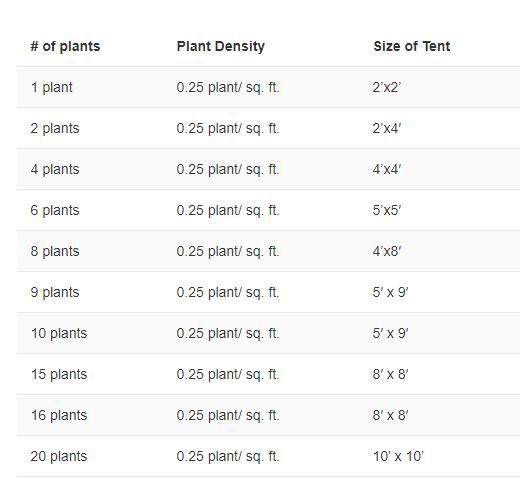
Topping ? 2?4 sq/ft per plant
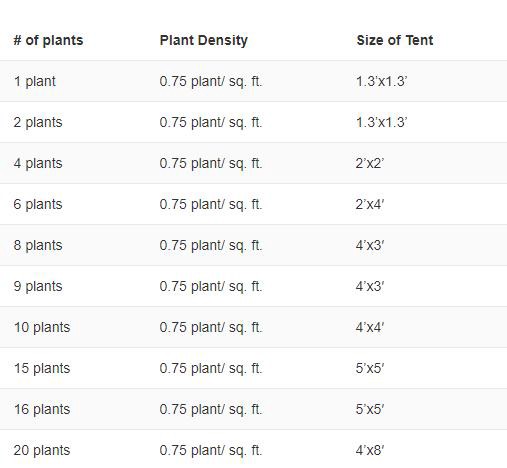
Topping has long been a favorite of marijuana growers.
It?s easy and doesn?t require any extra setup.
If grown undisturbed, most cannabis plants will grow one huge top (known as the cola).
The idea behind topping is forcing the plant to grow more than one cola-which translates to more bud!
To top a cannabis plant all you need to do is remove the growth tip and it will split into two more.
You can split two into four, four into eight and so on.
Topping your plants once will turn it into a cannabis bush while topping it a bunch will turn it into an inverted Christmas tree with all the growth at the top of the plant.
Once topped, plants grow sideways more then up allowing you to control the height of the plant.
Low-Stress Training (LST) ? 2 sq/ft per plant
Low-Stress Training is training your cannabis plants without the stress that topping or pruning put on the plant.
In case you didn?t know, the intensity of light from a source is inversely proportional to the square distance from the source (This is known as the Inverse-square Law of Light).
LST takes full advantage of this by slowly moving the top of the plant out of the bottoms way so it can receive more light.
More light = more bud.
You need to take your time training your plant to grow laterally, or in a circle around the pot, if you go too fast you can put too much stress on the plant.
To train it, use string or wire tied around plant branches and the planter to keep pressure on the branch while moving it where you want it to go.
HOW MUCH LIGHT DOES MY GROW-OP NEED?
It?s not as simple as purchasing as many of the most powerful grow lamps you can get your hands on. Every grow space is different. But two factors always need to be tightly controlled and constantly monitored. Temperature and relative humidity (RH) are the key environmental conditions the indoor grower regulates. You need the right tools. Invest in intake fans, extractor fans, and if available, air-con or heating.
HID ? HIGH INTENSITY DISCHARGE
HID lamps are a great source of illumination for the grow room and still favoured by most professionals. Unfortunately, MH and HPS lamps run hot and will significantly increase your power bills, too. One 400?600W bulb per m is a good rule of thumb. Although, you may need to scale down to a 250W bulb. Consider improving side reflection with Mylar sheeting if you can?t keep temperature and RH dialled-in. Using high-powered old-school lighting necessitates the use of more powerful fans and possibly air-con, or else the grow-op may run too hot.
LED ? LIGHT EMITTING DIODE
Modern LED grow lights run much cooler and more efficiently than HID. The main drawback with next-gen LED is the substantial investment required for a decent high-quality kit. Over the long-term, you can recoup with the savings you make on the power bill. Choose your LED kit carefully as not all LED?s are created equal. At present, 3W diodes and COB appear to be the most promising technologies. Less heat and more usable light per watt can also save you some money when it comes to selecting fans to regulate airflow.
CFL ? COMPACT FLUORESCENT LIGHT
CFL can only take you so far. Sure, they are economic and efficient, but only to a point. In this writer?s opinion, cool white CFL is fine for vegetative growth and rooting clones, but nothing more. Using CFL?s alone for the bloom phase is not recommended. However, adding CFL as a supplement to HPS during bloom can be a winning combination.
